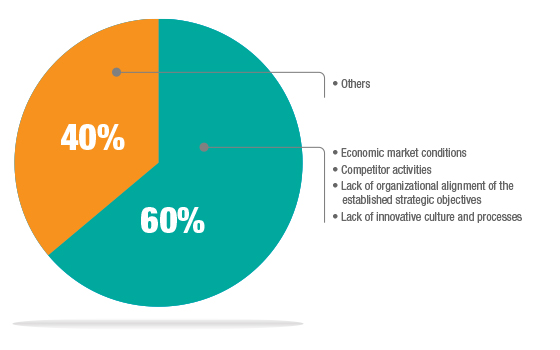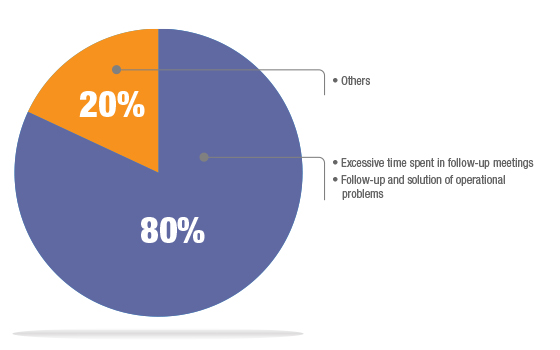Four days prior to month-end closing, the Sales Director is preparing for his 8 am weekly meeting with the regional managers. On his way to work, he is thinking about a series of questions to discuss during the meeting: What actions must we take in regions in which we are not meeting our goals? Why have we been unable to retain clients who have stopped purchasing our product? Why have clients called to report service problems? Why has the new product line failed to reach our projected sales objectives? Why is the sales margin in certain regions or product lines on the decline? Do we need to establish a new policy regarding the application of discounts or incentives in the face of recent complaints by certain clients? These, along with an endless list of questions, make the morning traffic seem like a piece of cake.
He knows that he is about to walk into a parade of trend charts, data tables showing current progress, arguments, counterarguments, arguments to the counterarguments… but in the end, as in every follow-up meeting, he will be left with uncertainty that the agreements will truly be met and yield expected results. This is where the first headache of the day begins.
Does this sound familiar?
This situation is the everyday scenario for hundreds, if not millions, of people in executive positions in different industry sectors. It is not a problem that concerns solely medium-size, large or multinational enterprises, but rather one that occurs regardless of the size or market in which each organization competes. So, what are the factors that give rise to these catalysts of executive migraines?
According to a study* performed by Sintec in 2013 on multisector enterprises of distinct revenue segments, the problem lies in the lack of organizational skills in middle and senior management that guarantee consistency between a sales strategy and its implementation in the market, as well as the homogenous implementation of said strategy throughout the organization. In other words, there is no effective Business Management Model.
Understanding the ache
The study examined the difficulties an enterprise faces in meeting the established annual market objectives. The answers varied in form but not in content. A summary of the study is presented below, emphasizing on 4 essential points.
- What are the main barriers to a company’s growth when following the strategic business objectives?
- What are the main challenges faced by management once the annual business plan is implemented?
- What are the main limitations the sales force faces in the market in order to attain its objectives?
- What are the activities with less added value performed by company management and which higher added value activities must it spend more time on?
The following graph shows the 4 most frequent barriers indicated by managers:
The majority of the managers agreed on the following challenges:
The 6 most common limitations were:
There was more agreement in the responses to this point:
The responses given by this group of executives allowed us to identify certain patterns:
- External and internal challenges and limitations exist in terms of the organization.
- Focusing on controllable internal factors, we were able to identify 4 response categories:
- Definition of issues or lack of agreements.
- Definition of issues and attachment to previously established definitions.
- Problems related to a lack of employee skills/infrastructure.
- Lack of collaboration among the workforce.
3 Sources of the Executive’s Migraine
Now, how can we link the responses from the study to the situation faced by the Sales Director we talked about at the beginning? If we reorganize the information, placing it in an entirely commercial context, we are able to group the following three large blocks of problems:
- Lack of definition of business processes that systematically guide performance.
- Time distribution in client portfolio management.
- Preparation for visits.
- Available business intelligence information.
- Application of promotions or new product lines for each client.
- Specific activities that should and should not be carried out in visiting a client or point of sale…
- Lack of coordination between the back and front sales offices.
- Lack of an executive management model that allows flexible and effective follow-up.
An enterprise must implement distinct sales processes for each of its markets, channels or segments, but how can it expect positive results if the series of routines and activities that the Sales Force must perform throughout the business cycle is not clearly defined?
This involves issues such as:
The list is endless.
Sales Force processes and routines require support from other areas. They cannot get the job done alone, but rather require assistance from areas such as: Marketing, to adjust the quarterly promotional plan to suit the realities of the local market; Administration, to offer fast and flexible service in managing credit situations; and collaboration tools and routines to be able to transmit problems in the field to the units responsible for their follow-up and solution (for example, late deliveries or the arrival of incorrect product samples).
The back office is a sales service organization and, as such, is also responsible for attaining market objectives. Likewise, the Sales Force must collaborate with back office areas in the design, deployment and implementation of functional strategies and tactics in the market. It is a team rowing in the same direction rather than a competition between areas. When this synchrony is not achieved, neither are the objectives.
Let us consider the following scenario:
Our daily life results in an undertaking that is full of activities, appointments, meetings, facts and more, making it practically impossible for us to order problems and determine relevance. The absence of a work system that helps us outline priorities, the control points and business indicators which guarantee Senior Management a method focused on results may not be reliable.
In the absence of a systematic management model, everything is urgent, all clients are demanding, everyone points out each other’s’ faults and the Sales Force makes more than enough justifications.
Under these circumstances, Management faces more unanswered questions than it does certainty in regard to future accomplishments.
The Antidote to the Senior Management Headache
The Business Management Model is comprised of a set of elements that work systematically to empower Management with control and correction mechanisms. Within the context of a market served by enterprise, the business management model allows us to link a business strategy to the operational sales mechanism, the sales staff and, ultimately, to the pursued business objectives.
Figure A shows the organizational structure upon which the Business Management Model must be built, the main information flows and the organizational skills to develop.
The Business Management Model cycle involves 5 key skills:
1- Design business strategies and tactics. The support functions and staff structure of business management are responsible for developing organizational skills and business processes that define feasible value proposals, recognizing the differences between segment, region and channel.
2- Coordinate deployment of business strategies and tactics. Within every organization, as slim as it may be, the complexity of working with multifunctional teams and high geographical dispersion is always present. The key lies in clearly establishing responsibilities and teamwork routines and preventing duplication and the “tell everything to everyone syndrome”.
3- Trickle down instructions on the organizational structure. One organizational skill to develop is: synthesis and prioritization of strategies and tactics into concrete instructions for each process of business execution within the operation, continually segmenting in accordance with the target market. It is also necessary to develop information technology solutions that permit systematic communication integrated in the operation.
4- Establish methods and tools for gathering information on the market and the enterprise’s business execution. A key skill to develop is establishment of information indicators and sources for each market segment on which the management model will be based.
For example, more detailed control mechanisms are required for the Sales and Collection areas in order to understand what is or is not happening in the front end of business operation. That is, it is necessary to measure what is to be controlled.
Distinct variables shall be considered, such as: frequency of visits, sale of each product line, price combinations, quality of execution at the point of sale, quality and frequency of client development activities, etc.
5. Manage market results and information. This is the final part of the cycle. Here, the energy tends to be focused on improving performance through follow-up meetings, generation of Business Intelligence reports, analysis of results, etc.
Nevertheless, in order to manage effectively, the first 4 steps of the model must be developed. They supply raw material in the form of information.
On the other hand, management routines must be created for each position that define the issues to be addressed in meetings, which clearly specify the participants, the roles to be played, the information that must be prepared and, primarily, the final deliverables that must be worked individually and those that require teamwork through review and approval routines. In addition, integration must take place of performance indicators with overlapping elements from the back office, the sales force and the supervising staff.
Finally, a management model must be supported by a compensation system that clearly rewards performance on results but also adherence to processes.
Conclusions
The problems that occur in an enterprise’s business function comprise one of the most difficult points for management to acknowledge. In the end, products sell, clients are loyal and brands are recognized, but accepting that there are ways to improve market performance, and therefore, grow (by winning or defending market participation) in the most feasible manner is the first step in considering change.
Markets have become more complex, clients are more demanding and there are more products, new activities on the part of the competition and more regulations to fulfill. In a context such as this, it is necessary at all times to perform self-diagnosis and recognize actions that may be taken. This document indicated some of the fastest ways to improve business performance: a flexible, effective business model that integrates multiple functions that are required to conquer and retain clients. It is the aspirin among many medications with the power to relieve that headache that begins right around 8 o’clock in the morning.
*Study applied to 19 enterprises in the sectors of consumer goods, capital goods, automotive, construction materials and industrial products. Geared toward Sales, Commercial and Marketing Top Management Executives.






